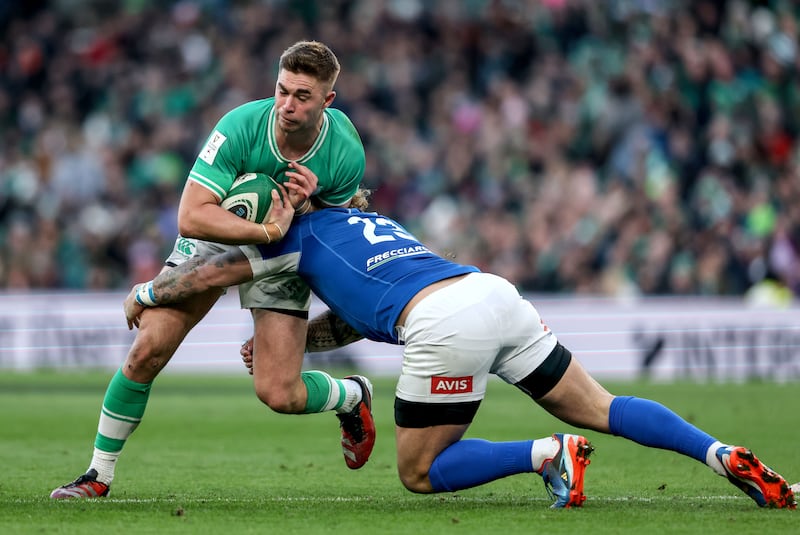Jack Crowley offered a throwback to his teenage days, the high knee goose-step, sliding sideways, stopping on a sixpence, before changing direction and accelerating through a thicket of blue-shirted Italians, arms flailing as they initially failed to halt his progress.
It was far from a single snapshot; the Munster pivot was a green-shirted pimpernel that tormented the visitors for much of the afternoon. It was reminiscent of the way the 24-year-old Innishannon native used to strut through matches for the Irish 20s, a highlights reel of precocious excellence, his talent unconstrained in that very appealing free-spirited way.
He was encouraged to pursue that approach and on Sunday at the Aviva Stadium there was flashes of that dashing individualism; crucially, though, it had purpose, pursuing the greater good for his team.
This match demanded a slightly different skill set to Marseilles, one where Ireland would be afforded greater latitude in an attacking capacity, to put ball through hands and explore the edges of the Italian defence. That meant softening them up, applying the old rugby maxim about “earning the right to go wide”.
READ MORE
Ireland pummelled Italy in close, looking for muscular, direct carries to either break the gainline and get into the backfield or force their opponents to constrict in defence. Six changes from the victory over France necessitated a bedding-in period as the team tried on the game plan for size. It fit with a bit of tugging and tweaking.

Italian demolition job with Gerry Thornley and John O'Sullivan
Crowley was the principal engineer in terms. Italian captain Michele Lamaro tested the Irish outhalf’s resolve with a rib-tickler tackle early on, the sort of opportunity that openside flankers dream about.
It probably hurt but Crowley’s expression didn’t change. Playing on the gainline requires courage to draw and execute a pass milliseconds before contact. Lamaro couldn’t resist Crowley’s siren call and stepped out of the line. The Italian’s punishment was to watch helplessly as Crowley put a team-mate through the space that he’d just vacated.
Italy didn’t learn from the folly of chasing Crowley in an unstructured way. The Irish outhalf punished them again with a little help from the imperious Hugo Keenan, who cut a gorgeous line to complement Crowley’s sleight of hand, a doozy of a no-look pass; for all the world it appeared that Crowley was going to play the ball out the back of the pod.

He offered a shimmering presence, elusive for the most part in his running, but also nuanced in his distribution. When an outhalf gets multiple touches on the ball in quick succession in the one sequence, two things are certain – the speed of ball is of the premium variety and there are mismatches to be exploited in the defensive line for the sharp-witted.
Those characteristics were very much in evidence in the outhalf’s work in the build-up to Dan Sheehan’s try, Crowley’s second involvement, a one-handed offload taking out two defenders, the definite breach point in the preamble to the try.
The newly minted midfield axis of Crowley, Stuart McCloskey and Robbie Henshaw worked well collectively and individually, and two of the three had been involved in the build-up to Ireland’s first try scored by the Irish outhalf.
Henshaw’s power through contract took him through the blue line, Crowley’s footwork bamboozled the defence, and he was back in situ when Craig Casey’s beautifully weighted pass goaded Ange Capuozzo into a rash decision.

It wasn’t all perfect, Crowley missed a clear-out at a ruck and grubber-kicked over the dead-ball line, the decision perhaps as flawed as the execution given the other choices on offer. He lost his gumshield at one point but never his composure. He appears to have the capacity to shrug off mistakes in favour of staying “next-moment focused”.
It’s a precious quality that’s appreciated by coaches and team-mates. Another aspect at which he excelled was his pass execution, changing the point of attack and inviting team-mates on to the ball. Ireland led 24-0 when Keenan limped off and Crowley was redeployed to fullback with Harry Byrne coming on to take up the outhalf duties.
Crowley took a little while to get up to speed with his new role, on one occasion tiptoeing a little close to the touchline and getting bundled into touch but he occasionally slipped in as first receiver when Byrne wasn’t available.
At the start of the Six Nations Championship the spotlight was firmly on Crowley as observers looked to see how the post-Johnny Sexton era would begin. Two matches in and there’s an argument that the Munster outhalf couldn’t have done much more.
Marseilles placed certain demands on him and he responded with a performance of impressive substance. Against Italy he was required to show different qualities and was no less capable. He’s taken the ball and run with it admirably, so to speak.
















